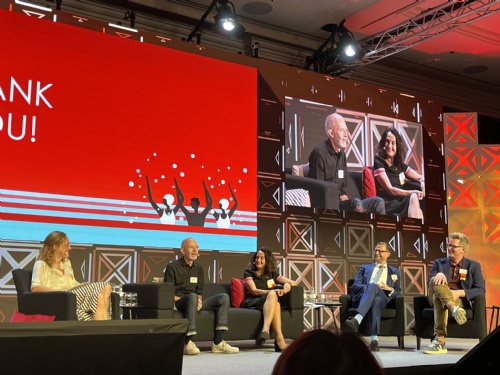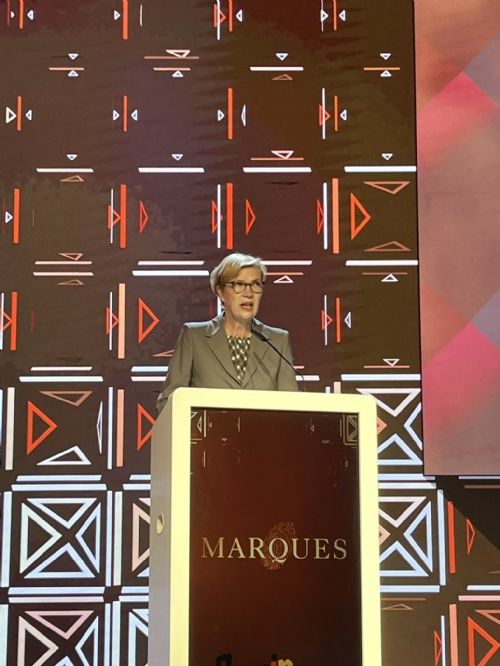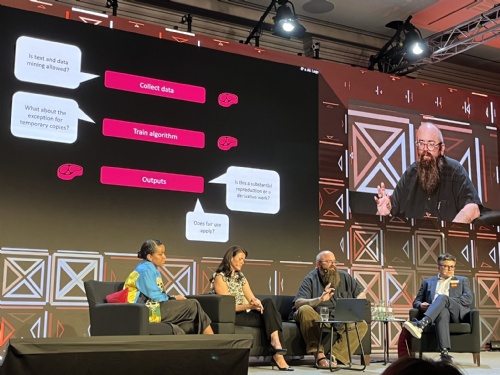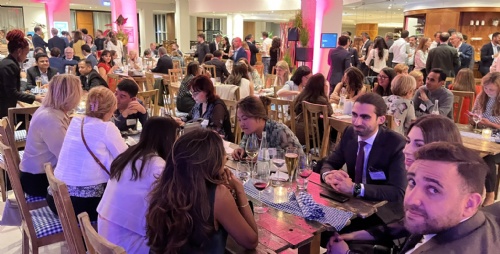Now in its twelfth year, Class 46 is dedicated to European trade mark law and practice. This weblog is written by a team of enthusiasts who want to spread the word and share their thoughts with others.
Click here subscribe for free.
Who we all are...
Annual Conference 2023: Parts 1 and 2
 “Building trust takes a long time, but it can be easily lost,” said session chair Simone Pelkmans, Deloitte Legal, The Netherlands, introducing the first panel session of this year’s MARQUES Annual Conference in Berlin.
“Building trust takes a long time, but it can be easily lost,” said session chair Simone Pelkmans, Deloitte Legal, The Netherlands, introducing the first panel session of this year’s MARQUES Annual Conference in Berlin.
She added that the 2023 Edelman Trust Barometer showed that people view business as competent and ethical – but want businesses to do more to address social and economic challenges.
Trust in brands
The panel’s first speaker, designer André Stauffer of Metadesign.com, Germany said he trusted in brands for three reasons:
Brands have a mission: “They have an important role because people trust them, they have visibility and people expect them to take a stand,” said André, citing Patagonia’s “Don’t buy this jacket!” campaign.
Brands have personality: for larger organisations, this is rooted in brand positioning – their purpose, values, competencies, benefits and experience. “Most successful brands have done this exercise and they are ready to tackle the future,” said André.
Brands have design: this is a powerful tool that can transport emotion, provide information and create excitement as with the Roarington virtual ecosystem of classic cars.
 |
|
The Annual Conference was formally opened by Eva Schewior, President of the German Patent and Trade Mark Office. She described the development of trade marks in Germany form the founding of the Imperial Patent Office 146 years ago, through the landmark 1894 Act on Trade Marks, the introduction of service marks in 1979, digitalisation in the 2010s and the recent registration of the 3 millionth trade mark application. She highlighted the recent growth in applications from China, including for marks with Chinese characters, the prominence of words and colours relating to sustainability in many trade mark applications today and the impact of digital technology – with more than 75 applications so far including “NFT” and more than 1,200 including “Blockchain”. |
The most important thing for a branding agency is empathy and understanding of the client’s business. Current trends include sustainability – which has its own visual code, with simplified hand-drawn logos – diversity and accessibility – which affects the colours used in branding. “Storytelling is part of branding,” said Andre. “Let’s contribute to brands that matter.”
Change and consistency
Claudia Pappas, Thyssenkrupp Intellectual Property GmbH, Germany spoke about “changing to stay the same”. She described the evolution of Thyssenkrupp since 1811 and the development of its brand. “Today the brand is about trust, modernisation and unification,” she said: the wording is all lower case and the previous arch and ring logos have been merged.
At one point, the company had 180 individual brands and no central database of trade marks. “We now have trade mark coordinators in each and every business unit and in the regions,” said Claudia. “For engineers, it’s not normal to work with brands … you have to train them that brands are important,” she added. From 2016 to 2018, a new brand promise led to the new logo and claim “engineering.tomorrow.together”.
Today, the company is facing new challenges ranging from the shortage of skilled workers to high energy prices and the green transformation. It has therefore launched the “Take a Chance/Make a Change” campaign made by employees for employees.
Thomas Wagner shared some lessons from Faber-Castell AG, Germany – a company that dates back to the mid-18th century and the producer of the first branded pencil. Its founder was also one of the initiators of the German Trade Mark Act.
In the last 20 years, Faber-Castell has become a premium brand and also developed its cosmetics business. It has also promoted education and social responsibility, and has a unique forestry project in Brazil. “A strong value system has created trust among employees,” said Thomas, who also emphasised the importance of forecasting global trends. One of these is that consumers are switching to lesser-known brands that are more sustainable.
Brand values in diversity
Bill Budd, Virgin Enterprises Ltd, UK explained how Virgin has sought to retain its values as it has expanded from a small company to one with diverse products and services in a range of sectors, while remaining family led. “Our purpose – changing business for good – is very important,” said Bill. “Everything we do tries to ladder up to that responsibility.”
“We’ve diversified enormously over 50 years,” he added, and sticking to its values has been difficult at times, but it has always been purpose-led. For example, in the 1980s Virgin founded the Mates brand of condoms to help tackle the AIDS crisis.
The brand purpose is embedded in its amended articles of association (which require directors to consider all stakeholders), its purpose filter and philanthropic enterprises such as Virgin Unite and Virgin Startup.
For the Virgin Atlantic airline, this has led to new products for single parents, removing Seaworld from its packages and introducing genderless uniforms, as well as changes to its advertising to emphasise inclusivity while remaining bold and original.
The metaverse
 In part 2 of the Conference, Risks and Rewards for Brands in the Metaverse, speakers discussed the future of brands in Web 3.0 and blockchain, generative AI and 3D and immersive tech. During the session, Nelly Mensah, LVMH, France provided an explanation using as examples Dior NFT-enabled sneakers (modelled by panel chair Leo Longauer of LVMH) and Tiffany X Cryptopunk NFTIFFS. “You can participate in Web 3.0 while concentrating on what differentiates your brand,” said Nelly.
In part 2 of the Conference, Risks and Rewards for Brands in the Metaverse, speakers discussed the future of brands in Web 3.0 and blockchain, generative AI and 3D and immersive tech. During the session, Nelly Mensah, LVMH, France provided an explanation using as examples Dior NFT-enabled sneakers (modelled by panel chair Leo Longauer of LVMH) and Tiffany X Cryptopunk NFTIFFS. “You can participate in Web 3.0 while concentrating on what differentiates your brand,” said Nelly.
Generative AI is being used by brands to support customer service and client advisers, for example matching foundation colours. The metaverse is bringing 3D content, digital fashion, 3D display innovation and microverse mini-games, said Nelly: “We’ll see digital content overload on physical a lot more … It’s not just about games.”
Jana Arden, Capgemini, Switzerland, described the development of the metaverse since the early 1980s. She explored virtual economies and products, connect virtual and physical spaces, brand premiumisation and engagement and NFT loyalty programmes. She said brands should ask: “What does the metaverse mean for us? What is our relationship with metaverse?”
Jana also warned that the customer experience is not optimised yet, and there are lots of questions ranging from data and privacy to taxation. “We need to speak about the non-successful cases as well as the successful cases,” she added.
Law and the metaverse
 |
| The Welcome Reception on Tuesday evening had a German theme, with pretzels, schnitzels and currywurst and a brass band providing the entertainment. |
Finally, Julius Stobbs, Stobbs, UK discussed the legal risks. He introduced Blockchain domain names (subject of a recent article by the MARQUES Cyberspace Team) such as .eth, .crypto, .nft and .handshake, saying: “They’re a key aspect of getting involved in Web 30 and metaverse so there is a brand risk of not getting involved with them.”
Two of the big problems are anonymity and decentralisation. “There are a lot of unscrupulous parties,” said Julius, “and no set regulation.” However, traditional enforcement methods may be relevant including to get disclosure and freeze assets. “We are seeing the courts start to look at these things,” he said, citing recent cases in the EU, UK, US, Singapore and China including the Hermès International v Rothschild decision in New York.
Courts are also looking into some issues raised by AI, notably copyright, and the EU, US and UK are all looking into the regulation of AI. “There will potentially be a totally different regulatory framework in the future,” said Julius. “We need to watch the space to see how it develops.”
Posted by: Blog Administrator @ 16.49Tags: Annual Conference, Berlin, metaverse,


 Sharing on Social Media? Use the link below...
Sharing on Social Media? Use the link below...Perm-A-Link: https://www.marques.org/blogs/class46?XID=BHA5214

